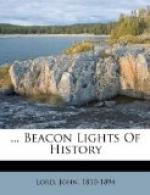Anselm had successfully battled with the rationalism of Roscelin, and also had furnished a new argument for the existence of God. He secured the triumph of Realism for a time and the apparent extinction of heresy. But a new impulse to thought was given, soon after his death, by a less profound but more popular and brilliant man, and, like him, a monk. This was the celebrated Peter Abelard, born in the year 1079, in Brittany, of noble parents, and a boy of remarkable precocity. He was a sort of knight-errant of philosophy, going from convent to convent and from school to school, disputing, while a mere youth, with learned teachers, wherever he could find them. Having vanquished the masters in the provincial schools, he turned his steps to Paris, at that time the intellectual centre of Europe. The university was not yet established, but the cathedral school of Notre Dame was presided over by William of Champeaux, who defended the Realism of Anselm.
To this famous cathedral school Abelard came as a pupil of the veteran dialectician at the age of twenty, and dared to dispute his doctrines. He soon set up as a teacher himself; but as Notre Dame was interdicted to him he retired to Melun, ten leagues from Paris, where enthusiastic pupils crowded to his lecture room, for he was witty, bold, sarcastic, acute, and eloquent. He afterwards removed to Paris, and so completely discomfited his old master that he retired from the field. Abelard then applied himself to the study of divinity, and attended the lectures of Anselm of Laon, who, though an old man, was treated by Abelard with great flippancy and arrogance. He then began to lee-tare on divinity as well as philosophy, with extraordinary eclat. Students flocked to his lecture room from all parts of Germany, Italy, France, and England. It is said that five thousand young men attended his lectures, among whom one hundred were destined to be prelates, including that brilliant and able Italian who afterwards reigned as Innocent III. It was about this time, 1117, when he was thirty-eight, that he encountered Heloise,—a passage of his life which will be considered in a later volume of this work. His unfortunate love and his cruel misfortune led to a temporary seclusion in a convent, from which, however, he issued to lecture with renewed popularity in a desert place in Champagne, where he constructed a vast edifice and dedicated it to the Paraclete. It was here that his most brilliant days were spent. It is said that three thousand pupils followed him to this wilderness. He was doubtless the most brilliant and successful lecturer that the Middle Ages ever saw. He continued the controversy which was begun by Roscelin respecting universals, the reality or which he denied.




